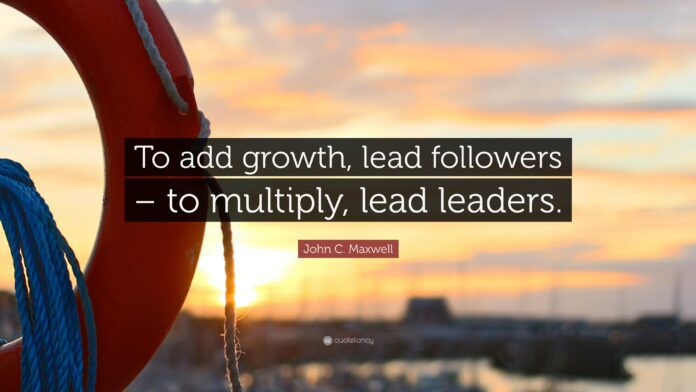Discipleship involves teaching people, through information and demonstration, to love and lead like Jesus. Paul said, “Be ye followers of me, even as I also am of Christ” (I Cor. 11:1). Just dumping information does not produce transformation. The root of the problem is a lack of discipleship, and the fruit it produces is a lack of multiplying disciples and leaders. Think of shifting your focus from doing to developing, with your eyes fixed on the truth that leadership development is an extension of your discipleship pathway. Begin leading others to increase their intimacy with Jesus and their influence for Jesus.
In Gaining by Losing, JD Greear gives five essential traits of multiplying leaders, areas for leaders to think through and wrestle with by applying them to their ministry context. In Spiritual Leadership, Henry and Richard Blackaby stated, “Spiritual leadership is moving people on to God’s agenda.” Discipleship and leadership development are not “a” ministry of the church but are “the” ministry of the church. C.S. Lewis said, “The church exists for nothing else but to draw men into Christ and make them little Christs. If they are not doing that, all the cathedrals, clergy, missions, sermons, even the Bible itself, are simply a waste of time.”
• The first essential trait is clarity. My friend, Drew Cline, stated in our missionary care conference that, “Clarity is kindness.” My, how true this is, because one of the greatest landmines in ministry is unrealistic expectations. Pastors, some people have expectations you will never be able to live up to because they are just not realistic. In leading your team, the team must be able to see what you see. You must be able to uncover your present reality, then cast a vision of God’s preferred future. It has been said that if there is a mist in the pulpit, there will be a fog in the pew. State it, teach it, draw it, diagram it and repeat it.
• The second essential is familiarity, repeating it over and over. You will be tempted to think, “Oh they already know this” or “They are tired of hearing this.” That is actually when they are just beginning to hear it, understand it and own it. Can they tell you how your discipleship pathway and leadership development work in your church? How familiar are they with the process and are they able to teach it to others? This takes time. Realize this process not only demands light but also heat. It is the ability to clearly state what it looks like, then also holding everyone accountable to the implementation of the process — turn up the heat.
• Another essential trait of a multiplying leader is proximity. People’s lives only change when they see it modeled. Developing multiplying leaders is less about a class where you teach leaders and more about a life you model in front of them. In The Multiplication Effect, Mac Lake stated, “He (Jesus) didn’t just randomly and spontaneously choose these men and invest in them — He had spent time getting to know them and letting them get to know Him. He walked with them, taught them, modeled evangelism with them, prayed for them and invited them to walk alongside Him.” That requires transparent close relationships.
• The fourth essential trait of a multiplying leader is equity. The ultimate goal is the transfer of leadership. In John 14:12, Jesus had His eyes on this goal, “…He that believeth on Me, the works that I do shall he do also; and greater works than these shall He do; because I go unto my Father.” The goal is not getting someone to help you but getting them to lead, own it and take responsibility for it. Mac Lake continued, “We are most effective at doing only the things we can do. If we try to do too much more, the ministry will exceed our capacity. If we are going to have any hope of fulfilling the Great Commission, we must develop leaders.”
• The fifth essential trait of a multiplying leader is humility. You must be willing to lead with an open hand by refusing to hold on too tightly to those you develop. They will move on many times, but that is the goal of multiplication. Hopefully, they may have a desire to plant a church and multiply what you are doing where God placed you, just like Paul watched Timothy, Titus and others. It is humbling because many times, you will watch your “best” leaders be the very ones who desire to multiply. You want to hold on to them, but that is all too often a spirit to control instead of a heart to commission.
It is a difficult path to navigate correctly, which requires a lot of prayer as you strive to make sure every step of ministry is God-initiated and driven by His agenda, not yours. It is a joy to develop leaders, then watch them flourish and multiply. It requires Clarity, Familiarity, Proximity, Equity and Humility by moving from operating as doers and becoming developers. The apostle Paul rejoiced in the truth of Titus developing into a multiplying leader, and he was able to leave him in Crete (Titus 1:5) knowing he would set things in order correctly. Paul referred to Titus as “mine own son after the common faith” (Titus 1:4).
J.D. Greear stated that this process of developing multiplying leaders is about 25% curriculum and 75% the life you live and model in front of them in close relationship. This is not discounting the importance of curriculum but rather emphasizing the value of what Jesus did in Mark 3:14: “And He (Jesus) ordained twelve, that they should be with Him, and that He might send them forth to preach” (emphasis mine). Mac Lake stated, “He (Jesus) intentionally spent the next three years of His life with these leaders, growing their faith, character, leadership and ability to produce more disciples.”



